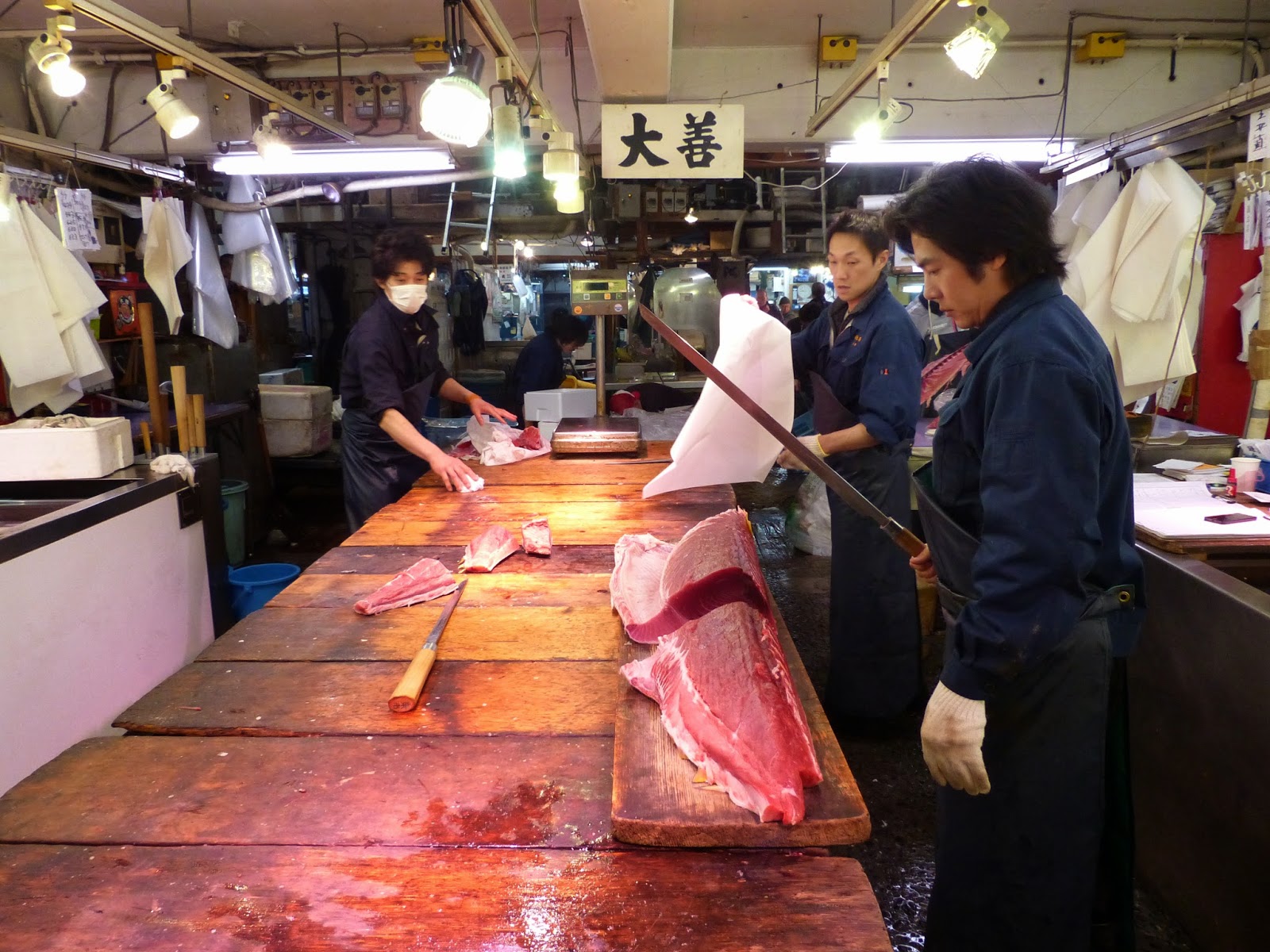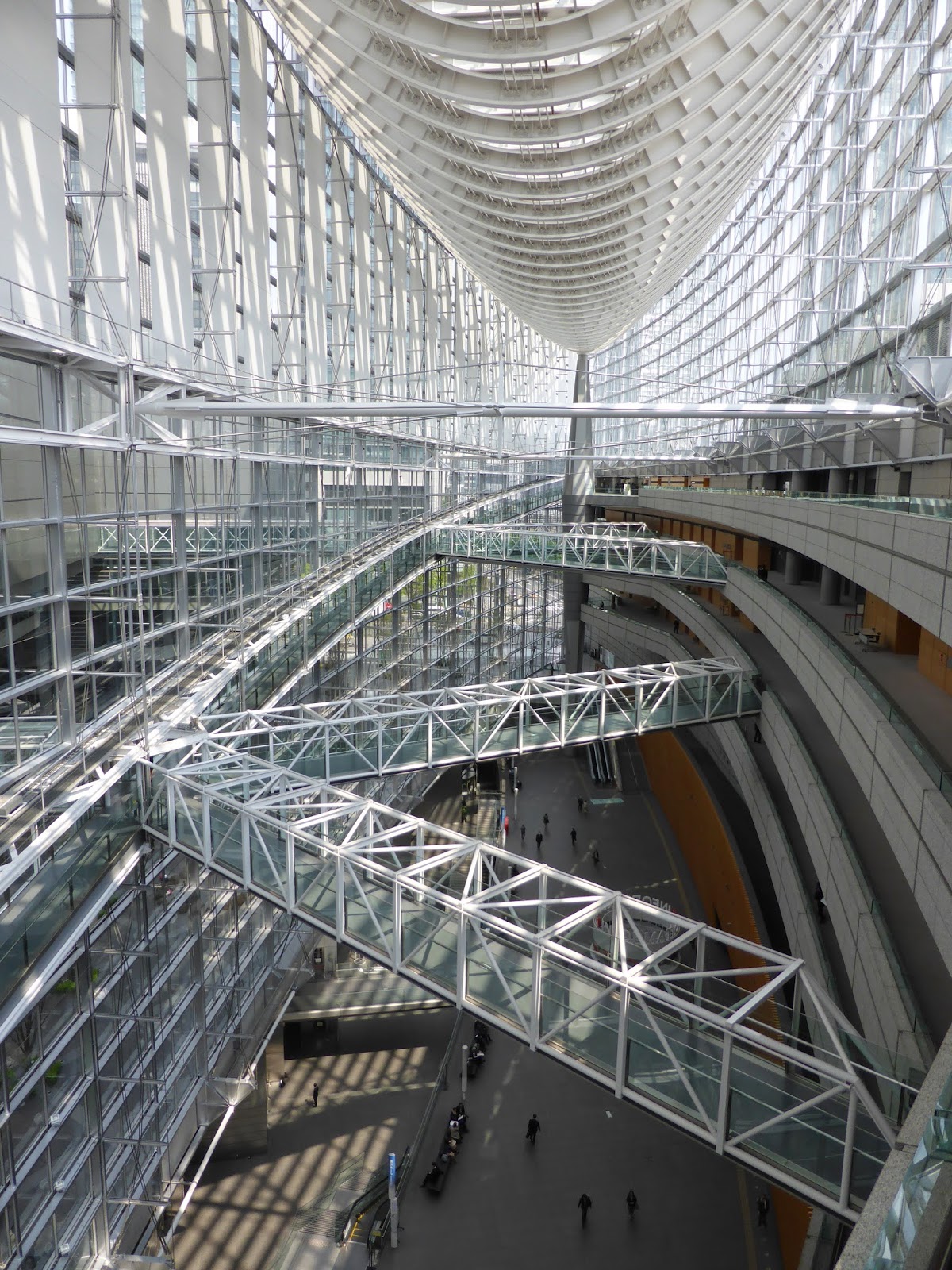As we said before, we had
a great time in Japan. We found Japanese people extremely polite,
providing us with a great quality of service. They were much more open to
foreigners than we expected. Especially after we heard and read all
these stories that the Japanese do not speak English and are very
isolationist. Clearly, we got fascinated with Japan and intend to come
back there one day. This is not to say though that Japan is an ideal
place – a paradise on Earth. Japan has also its darker side. As our travel went absolutely smoothly and our interactions with
the Japanese were very superficial, we could not really experience
this dark side. To tell anything about it we need to rely on what we have read or heard from other people or just on the minor things that we witnessed and we can only presume that they are symptomatic of something more serious.
Let's start with the
Tokyo fish market. This place is probably the largest fish
slaughterhouse on the planet. This is one of those sites, which makes
you realise that the Japanese can raise anything to the heights of
perfection – even the art of killing the fish. The main victim here is, of course - tuna, the favourite fish of the Japanese ...
... it's cutting is an art in itself, it requires very long and very sharp knives...
... lots of practice and concentration ...
... and as the Japanese are obsessed with purity, the white gloves are a must...
... the outcome must be always meticulously arranged.
The fish market is scary, but some specimen of seafood can still surprise with their beauty ...
Sometimes it gets a bit ... hmmm... obscene :)
Sometimes you get surprised by the mere size of things ...
No doubt that everything is very fresh here ...
.
.. and busy, busy.
We've read quite a lot
about the eccentricity or even perversity of Japanese pop-culture in general and visual arts in particular. Most of us have seen Japanese comic books (manga) or
motion-picture animation (anime) and for Western tastes they seem rather
violent. There are not many Japanese films infiltrating Europe,
though we can get the taste of Japanese action style in
Quentin Tarantino's 'Kill Bill' as it was inspired by the Japanese cinema. In this movie violence is so intense and surreal that it just gets funny. It's a never ending bloodbath, where the blood is splashing all around from freshly chopped off heads and limbs. Of course, there is a long way between the fish slaughterhouse in Tokyo and the human slaughterhouse in Japanese movies. Nonetheless when we see a bloke cutting tuna in white gloves, with a one-meter-long blade, with almost religious concentration on his face, the passage from Ian Buruma's book 'A Japanese Mirror comes to mind: 'One of the most typical nihirisuto heroes is the protagonist of a story, filmed many times, entitled 'The great Buddha Pass': Tsukuye Ryonosuke, a roaming sword fighter whose only purpose in life is to kill people with one clean swoop of his well tended weapon. He is not on the side of anybody or anything; and he is not choosy about his victims, as long as he can practise his murderous skills. [...] What is important is his style. [...]. The grotesque violence of the roaming killer is shown as a piece of a wonderful kitsch: the screen goes red as heads are lopped off and bodies are sliced in half. [...] The hero is the epitome of badness. [...] But he is also as artist and as such he is also admired.'
Let's look at another downside of the Japanese character - the lack of flexibility. For instance, we come to the hotel at 1:30 PM, they show us
a room that is already empty and ready, but there is no way we can enter the room before the fixed check-in time at 3
PM. It
is almost impossible to get a SIM card for your smartphone if
you are a foreigner; the only exception is to order it online at
least a week before your arrival. You need to fill in an online form where the warning keeps on popping up: 'please make sure that all the details
are correct as once you completed it, no further change will be
possible (for example they cannot re-send it to a different address
if you fail to pick it up at the initial one, which is clearly a risk
given that you travel and change the address frequently). The story of Sashimi rice
we have already described in a previous post.
Obviously, these are very
minor inconveniences but again we kept on wondering whether they were symptomatic
of some deeper traits of the Japanese character – conservatism, conformism
and vulnerability to social pressure. Japanese society is extremely
hierarchical and permanently obliges individuals to conform to
their prescribed role in the group.
Often the more socially oppressive a society gets, the more the youth will rebel, or at least try to stand out by a bit unconventional dressing style :)
The typical role of the man is to
be loyal first and foremost to his company and to do whatever the
boss requires of him. Most of the men feel a strong social pressure
to excel professionally, to deliver the best they can.
Japanese get perfectionist even when it comes to dog grooming :).
That's why
the men spend very long hours at work, which enables the Japanese
companies to deliver such a high quality of output, but often has
dire consequences for family life. The society where everyone
struggles to deliver its best, becomes the society of perfectionists;
for those who fail to satisfy the very high expectations the level of stress becomes unbearable, which sometimes leads to tragic consequences. Japan is the world leader in the
suicide rate. Even us, indirectly, we experienced that. On the 1st
of April, the transport system in Osaka, that usually works
seamlessly, got severely disrupted by two suicides. As we were later
explained, that was not a coincidence - the 1st of April
marks the beginning of the new financial year when many people find
out that that were dismissed from their job.
Japan is still a male
dominated society where the position of women continues to be weak.
Many Japanese women are even now expected to quit their job once they
get married and have children. The number of women in executive
positions in politics and business is still very low. They don't see
their husbands very much, as the men spend long hours working in the
office or getting drunk in a bar with their colleagues after leaving the office, as bonding with the workmates after hours is a very important part of
Japanese professional life. Indeed, we have continually seen men in
suits either coming back home late at night on the public transport
or just eating, drinking and getting noisy with their colleagues in
bars and eateries.
All the Japanese temples, irrespective if they are Buddhist or Shinto, will always show a great care to detail and will always be in perfect condition.
And one more intriguing Japanese trait, it's not dark at all, rather the opposite - the Japanese are obsessed with purity and cleanliness. One of our most interesting social experiences was a visit to the public onsen (natural hot bath). In Europe the main reason to visit hot baths is to relax in the saunas and soak the body in jacuzzis for a few hours. Whereas in Japan the main reason to go to onsen is to clean your body. It is truly amazing to see the Japanese washing themselves. Before entering the hot springs, they wash and scrub themselves for at least ten minutes, sitting on a small stool in front of the tap and shower handset. The entry into hot water (by hot we mean very hot) is just a dessert, a relatively short reward for all this previous washing effort. And after this dessert the main course of washing is thoroughly repeated again.
We could go on and on about the Japanese spirit. To cut long story short, Japan seems to be a much better place to travel than to live in. While staying only a short time, you get almost only the fruits of the bright side, without almost noticing the dark side. And some of the great things that made us feel so good may be exactly the outcome of the traits that make the life of the Japanese hard. The great quality of service is to a large extent the outcome of the long hours of work and the extreme professional perfectionism. When everyone gives its best the world becomes a better place and Japanese cities are the best testimonies of it. The agglomeration of Tokyo (including the cities of Yokohama and Kawasaki) is probably the largest megapolis on the planet. Nonetheless, there are almost none of the annoyances of the big cities: no traffic jams, no air pollution, no disturbing noises, no thugs.
Already the map of Tokyo underground transport system can give a good idea of the extensiveness of the city and the quality of the public transport.
Clearly there are millions of people, but apart from some key communication hubs, such as Ginza crossing, these people either miraculously disappear or they just don't bother anyone (streets are spacious, no one smells, no one runs into you).
All in all, even being in a Japanese big city can be relaxing and for sure it provides a lot of inspiration in terms of the aesthetics of the shops and modernity of its architecture.
634 meter tall Tokyo Sky Tree is one of the latest and best visible additions to Tokyo Skyline
Tokyo International Forum is one of the many buildings with an impressive modern design

























No comments:
Post a Comment